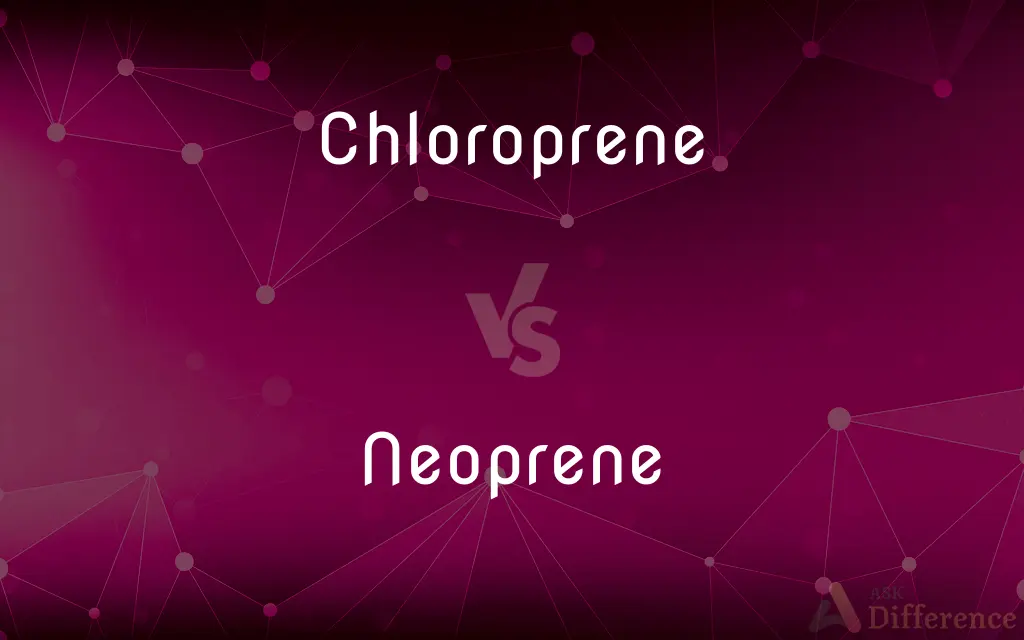Chloroprene vs. Neoprene — What's the Difference?
By Maham Liaqat & Urooj Arif — Updated on March 11, 2024
Chloroprene is the monomer, while neoprene is the polymer made from chloroprene, widely used for its durability and resistance.

Difference Between Chloroprene and Neoprene
Table of Contents
ADVERTISEMENT
Key Differences
Chloroprene is a liquid monomer used as a building block for various types of synthetic rubbers, known for its chemical resistance and flexibility. Neoprene, on the other hand, is a synthetic rubber created through the polymerization of chloroprene, offering enhanced physical and chemical properties suitable for diverse applications.
While chloroprene serves as a key raw material in the production of neoprene rubber, neoprene is recognized for its widespread use in wetsuits, gaskets, hoses, and adhesives due to its excellent weather, ozone, and heat resistance.
Chloroprene's utility lies primarily in its ability to undergo polymerization to form high-performance materials, whereas neoprene stands out for its versatility, being used in automotive, marine, and electronic industries among others for its superior durability and insulation properties.
The production process of chloroprene focuses on the synthesis of the monomer, which involves the chlorination and dehydrochlorination of butadiene. Neoprene, in contrast, is manufactured through the free-radical polymerization of chloroprene, resulting in a flexible, resilient material.
Environmental considerations play a significant role in the handling and use of chloroprene, due to its volatile organic compound (VOC) status and potential health risks. Neoprene, however, is often highlighted for its eco-friendlier alternatives and innovations in sustainable manufacturing practices.
ADVERTISEMENT
Comparison Chart
Nature
Monomer, liquid at room temperature
Polymer, synthetic rubber
Usage
Raw material in synthetic rubber production
Used in wetsuits, gaskets, hoses, adhesives
Properties
Chemical resistance, flexibility
Weather, ozone, heat resistance, durability
Production Process
Synthesis from butadiene
Polymerization of chloroprene
Environmental Impact
VOC, potential health risks
Eco-friendlier alternatives available
Compare with Definitions
Chloroprene
Chloroprene is a chlorinated hydrocarbon monomer.
Chloroprene is used in the production of synthetic rubber.
Neoprene
Neoprene is a synthetic rubber produced by polymerizing chloroprene.
Neoprene is commonly used in making wetsuits.
Chloroprene
Known for its chemical resistance.
Chloroprene's chemical resistance makes it suitable for industrial applications.
Neoprene
Exhibits excellent thermal and chemical stability.
Neoprene products are durable and long-lasting.
Chloroprene
Chloroprene is used as a raw material.
Chloroprene serves as a base in creating various rubber products.
Neoprene
Used in diverse applications from automotive to fashion.
Neoprene is favored in industries for its versatility.
Chloroprene
Can be hazardous if not handled properly.
Safety measures are critical when dealing with chloroprene due to its toxicity.
Neoprene
Eco-friendly versions are being developed.
Sustainable neoprene alternatives are gaining popularity.
Chloroprene
It's a colorless liquid under room temperature.
Chloroprene is stored as a liquid in industrial containers.
Neoprene
Resistant to water, oils, and weathering.
Neoprene gaskets are ideal for outdoor applications.
Chloroprene
Chloroprene is the common name for 2-chlorobuta-1,3-diene (IUPAC name) with the chemical formula CH2=CCl−CH=CH2. Chloroprene is a colorless volatile liquid, almost exclusively used as a monomer for the production of the polymer polychloroprene, a type of synthetic rubber.
Neoprene
Neoprene (also polychloroprene) is a family of synthetic rubbers that are produced by polymerization of chloroprene. Neoprene exhibits good chemical stability and maintains flexibility over a wide temperature range.
Chloroprene
A colorless liquid, C4H5Cl, that polymerizes to neoprene.
Neoprene
A synthetic rubber produced by polymerization of chloroprene and used in weather-resistant products, adhesives, shoe soles, sportswear, paints, and rocket fuels.
Chloroprene
(organic compound) The chlorinated derivative of butadiene 2-chloro-1,3-butadiene that is used (via polymerization) in the manufacture of synthetic rubber.
Neoprene
A synthetic rubber, a polymer of chloroprene, commonly used in wetsuits, laptop sleeves, orthopedic braces, electrical insulation, liquid and sheet-applied elastomeric membranes and flashings, car fan belts, etc.
Chloroprene
Derivative of butadiene used in making neoprene by polymerization
Neoprene
A synthetic rubber that is resistant to oils and aging; used in waterproof products
Common Curiosities
What makes neoprene different from other rubbers?
Neoprene stands out for its excellent weather, ozone, and heat resistance, along with its durability and versatility in applications.
How is chloroprene made?
Chloroprene is synthesized through the chlorination and dehydrochlorination of butadiene.
Is chloroprene hazardous?
Chloroprene is considered a volatile organic compound (VOC) and can be hazardous if not handled properly due to its potential health risks.
What is chloroprene?
Chloroprene is a chlorinated monomer used primarily in the production of synthetic rubber, known as neoprene.
What is neoprene used for?
Neoprene is used in various applications such as wetsuits, gaskets, hoses, and adhesives due to its durability and resistance properties.
Are there eco-friendly alternatives to neoprene?
Yes, eco-friendlier alternatives to neoprene are being developed, focusing on sustainable manufacturing practices.
What is the chemical formula of chloroprene?
The chemical formula of chloroprene is C4H5Cl.
What are the environmental concerns associated with chloroprene?
The main concerns include its status as a VOC and the potential for adverse health effects.
Can chloroprene be used alone in products?
Chloroprene is typically not used alone in products; it is primarily a monomer used to produce neoprene rubber.
Can neoprene be recycled?
Recycling neoprene can be challenging, but efforts are being made to find sustainable disposal or repurposing methods.
How is neoprene manufactured?
Neoprene is manufactured through the free-radical polymerization of chloroprene.
What are the key properties of chloroprene?
Chloroprene is known for its flexibility and chemical resistance.
Why is neoprene popular in the automotive industry?
Neoprene's resistance to oils and chemicals, along with its durability, makes it ideal for automotive applications.
What advancements are being made in neoprene production?
Advancements include developing more sustainable production methods and eco-friendlier neoprene alternatives.
How does neoprene perform in extreme temperatures?
Neoprene maintains its flexibility and resistance properties in a wide range of temperatures, making it suitable for extreme conditions.
Share Your Discovery

Previous Comparison
Wish vs. Will
Next Comparison
Mitten vs. KittenAuthor Spotlight
Written by
Maham LiaqatCo-written by
Urooj ArifUrooj is a skilled content writer at Ask Difference, known for her exceptional ability to simplify complex topics into engaging and informative content. With a passion for research and a flair for clear, concise writing, she consistently delivers articles that resonate with our diverse audience.














































